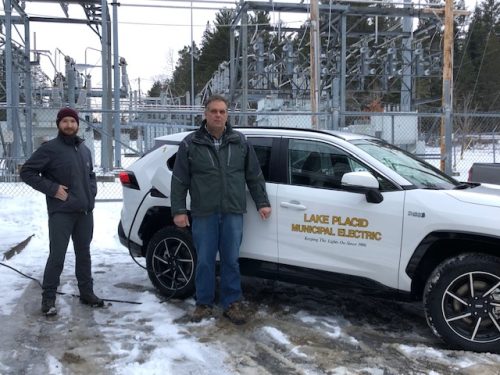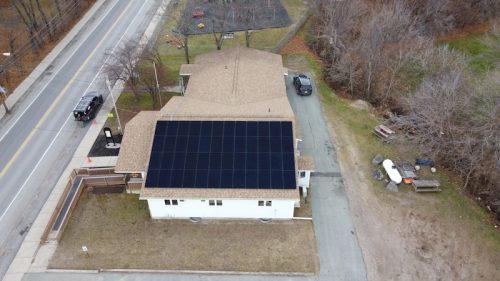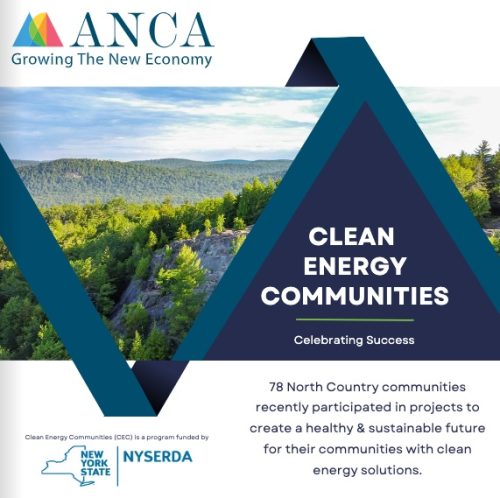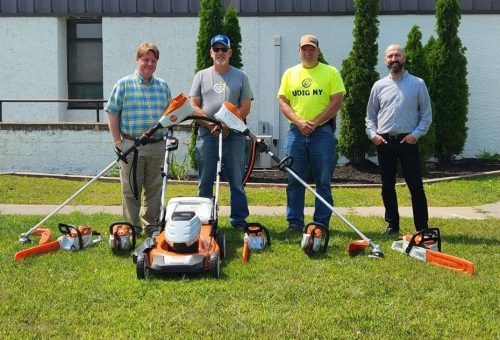By Nicole Draina, ANCA Clean Energy Communications Coordinator
As you drive around the North Country you’ll likely notice signs of our region’s clean energy transition. Slightly distorted from view, blocked by pines, are wind turbines on fallow farmland, solar panels at the base of mountains, and even hydroelectric dams along the winding river routes of the Adirondack Park. Some clean energy projects, like the wind farms in Franklin County, have been around since 2001, have been providing clean energy to New Yorkers for well over a decade..
Often when we pass by these power generating facilities, it feels like they are just part of the landscape — but they also have an important function. Many of us are unaware of the actual, tangible results these clean energy projects bring to the area. We might wonder: who owns them? Where does the energy go? Who does it actually help? And how much money are we saving by using them? Some of these large-scale projects have been implemented on municipal property, like the 42.8 MW wind project in the Town of Lowville. A symbiotic relationship between a renewable energy company and the Town, which benefited from the clean energy and earned points through NYSERDA’s Clean Energy Communities (CEC) Program for further funding.
However, often overshadowed by these large-scale clean energy projects, we occasionally fail to notice the small communities who participate in programs that provide energy-saving, cost-saving clean energy for their homes, businesses, and public spaces. As the year comes to a close, we want to celebrate community leaders who have taken advantage of state programs to help their counties, towns, and villages save money, leverage grant dollars, reduce carbon emissions, and support clean energy jobs.
Within the past year, ANCA Energy Circuit Riders (ECRs) have helped 57 North Country communities access clean energy solutions and savings by participating in the CEC Program. ECRs have assisted communities to complete “High Impact Actions” that have culminated in the award of more than $1.65 million in state funding for additional clean energy projects that benefit both residents and visitors to the region. It has been a remarkable year for CEC in the North Country, building on ANCA’s work coordinating the program here since 2016. All told, our ECRs have helped nearly 80 communities access over $3.5 million for energy projects over the course of three grant cycles.
by participating in the CEC Program. ECRs have assisted communities to complete “High Impact Actions” that have culminated in the award of more than $1.65 million in state funding for additional clean energy projects that benefit both residents and visitors to the region. It has been a remarkable year for CEC in the North Country, building on ANCA’s work coordinating the program here since 2016. All told, our ECRs have helped nearly 80 communities access over $3.5 million for energy projects over the course of three grant cycles.
CEC High Impact Actions include upgrading to energy efficient street lights, purchasing electric vehicles and landscaping equipment, weatherizing municipal buildings, hosting educational trainings, installing heat pumps, and implementing community campaigns to assist residents with making upgrades in their homes and businesses. Together, these individual actions add up and help build community-wide resiliency and economic opportunities.
The need for more clean energy solutions for increased resiliency has become more dire. As storms and weather patterns intensify throughout the region, causing events from floods and droughts to wildfires and tornadoes, our North Country communities come together to support each other. These climate resiliency actions are just one way of showing that.
Look closely as you drive through communities in the North Country, and you’ll see the cohesion between the towns and clean energy solutions. Existing structures have been improved to increase energy efficiency, charging stations for accessibility when commuting, and even renewable resources that help power facilities — a seamless and sustainable solution that supports local economies.
For example, on Route 73 just outside of Keene Valley, you’ll notice a wooden sign on a small building for “McDonough’s Valley Hardware” and “Village Post Office.” At the back of the parking lot, just off the pavement in the dirt, there is an EV charging station. In the other direction, in Hamilton County, you might see town employees using their electric landscaping equipment. And way up north, near the Canadian border, the village of Malone has installed LED street lights to cut energy costs. It’s small communities like these that are making changes toward a cleaner, healthier and safer environment.
safer environment.
In the past year alone nearly $1.65 million dollars have been allocated to your neighbors, family, friends, and community leaders who will see tangible results from programs like CEC. It might be your neighbor who is installing those LED lights or a family member providing the building insulation plan for the local community center. Not only will these clean energy actions support good-paying, local jobs, they will also preserve our home for generations to come.
As 2024 winds down, we’d once again like to celebrate the dedication and hard work of our North Country communities as they have taken on clean energy actions and projects that help reduce costs and carbon emissions, while building climate resiliency and a strong clean energy future for our region. Each community has chosen high impact actions that are individualized to their community needs.
ANCA is honored to provide the continued support and technical assistance to make these actions a success for our North Country communities. Please take a moment to celebrate these communities by browsing our Clean Energy Communities digital booklet:

If these topics are of interest to you, please join us at our Clean Energy and Small Business. Big Opportunities. joint conference in Spring 2025. Registration will open this winter.

Photos:
-
Lake Placid municipal electric purchased a Toyota RAV4 plug-in Electric Vehicle in 2021, a high impact action that in 2024 earned the Village a $50,000 CEC grant to purchase a fully electric Ford Lightning pickup truck
-
Black Brook earned a $50,000 CEC grant in 2019 allowing town leaders to complete 2 projects: convert town street lights to energy-efficient LED, and install a 16.3 kw solar array on the town hall roof.
-
Town of Plattsburgh staff with electric landscape equipment purchase with CEC program funding
